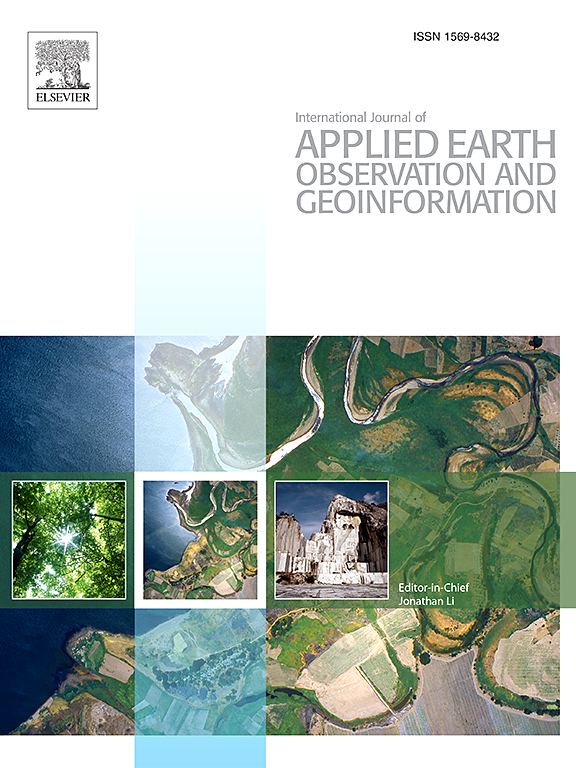Machine learning and clustering for supporting the identification of active landslides at national scale
IF 7.6
Q1 REMOTE SENSING
International journal of applied earth observation and geoinformation : ITC journal
Pub Date : 2025-05-17
DOI:10.1016/j.jag.2025.104608
引用次数: 0
Abstract
Landslides are one of the major geohazards causing significant economic damage and loss of life, with impacts expected to increase due to climate change. Landslide inventory maps (LIMs) are essential for risk management and reduction, but they usually remain an overlooked issue, especially over very large areas, i.e. at a regional or national level. Nowadays, extensive interferometric satellite radar data with wide area coverage are profitably available, but their potential can be not fully exploited due to the challenge of managing them. In this context, we used space-borne advanced Interferometric Synthetic Aperture Radar (InSAR) data at a national scale, in order to create a useful database of active slope instability movement areas to rely on where the landslide inventory map is missing or largely incomplete. Specifically, we provide insights into a new approach, proposing a national-scale method that combines Machine Learning (ML) and clustering tools, which are crucial to manage a huge amount of data. The proposed methodology has been applied to Great Britain. The use of a ML algorithm, specifically Hierarchical Density-Based Spatial Clustering of Applications with Noise (HDBSCAN) for noise filtering, has allowed the InSAR dataset to be reduced from approximately 6.5 million points to about 3.8 million points per component. Thus, implementing ML along with Slope Units for geomorphological reliability, and tools for identifying and classifying active deformation areas yields an InSAR landslide inventory map. Through this process, 336,557 Slope Units have been classified; of these, 5% show discrepancies between landslide inventory and InSAR data. Identifying these areas, along with those classified as landslides by both datasets, is crucial for risk management as it highlights areas that require closer inspections.
支持在国家范围内识别活动滑坡的机器学习和聚类
山体滑坡是造成重大经济损失和生命损失的主要地质灾害之一,由于气候变化,其影响预计会增加。滑坡清单地图对风险管理和减少至关重要,但它们通常仍然是一个被忽视的问题,特别是在非常大的地区,即在区域或国家一级。如今,具有广域覆盖范围的广泛干涉卫星雷达数据是有利可图的,但由于管理这些数据的挑战,它们的潜力无法得到充分利用。在这种情况下,我们在全国范围内使用了星载先进干涉合成孔径雷达(InSAR)数据,以便创建一个有用的活跃边坡不稳定运动区域数据库,以依赖滑坡库存地图缺失或大部分不完整的地方。具体来说,我们提供了一种新方法的见解,提出了一种结合机器学习(ML)和聚类工具的全国范围的方法,这对管理大量数据至关重要。所提出的方法已应用于英国。使用ML算法,特别是用于噪声过滤的基于层次密度的应用空间聚类(HDBSCAN),可以将InSAR数据集从每个组件的大约650万个点减少到大约380万个点。因此,将机器学习与坡度单位(Slope Units)结合起来,用于地貌可靠性,以及用于识别和分类活动变形区域的工具,可以生成InSAR滑坡库存图。通过这个过程,已经分类了336,557个坡度单元;其中,5%显示滑坡库存与InSAR数据之间存在差异。识别这些区域,以及被两个数据集归类为滑坡的区域,对于风险管理至关重要,因为它突出了需要更仔细检查的区域。
本文章由计算机程序翻译,如有差异,请以英文原文为准。
求助全文
约1分钟内获得全文
求助全文
来源期刊

International journal of applied earth observation and geoinformation : ITC journal
Global and Planetary Change, Management, Monitoring, Policy and Law, Earth-Surface Processes, Computers in Earth Sciences
CiteScore
12.00
自引率
0.00%
发文量
0
审稿时长
77 days
期刊介绍:
The International Journal of Applied Earth Observation and Geoinformation publishes original papers that utilize earth observation data for natural resource and environmental inventory and management. These data primarily originate from remote sensing platforms, including satellites and aircraft, supplemented by surface and subsurface measurements. Addressing natural resources such as forests, agricultural land, soils, and water, as well as environmental concerns like biodiversity, land degradation, and hazards, the journal explores conceptual and data-driven approaches. It covers geoinformation themes like capturing, databasing, visualization, interpretation, data quality, and spatial uncertainty.
 求助内容:
求助内容: 应助结果提醒方式:
应助结果提醒方式:


